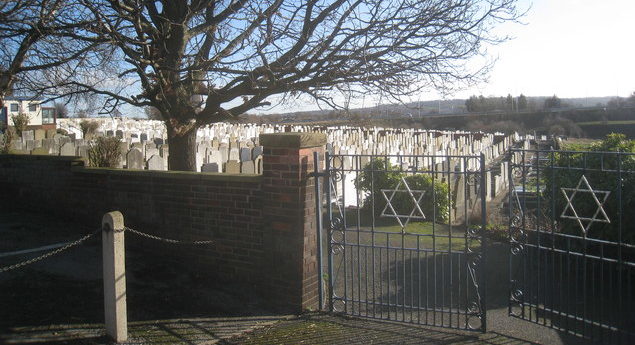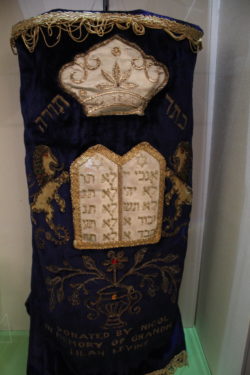Jewish Remembrance in Leeds

A guest blog from Patrick Bourne, with thanks to the Leeds Jewish Representative Council, the United Hebrew Congregation, Leeds and the Beth Hamidrash Hagadol Synagogue for providing information
Along with the Irish, the largest migrant community in early twentieth century Leeds were Jews, many of whom had fled persecution in Russia and Poland. Some 15,000 Jews had settled in Leeds by 1901, and many worked in the clothing industry. Most lived in an area called the Leylands in the early twentieth century, but by the late 1930s the community had largely left this area due to slum clearance. Many settled in the Chapeltown district and, from the 1950s, Moortown and Alwoodley. The first Jewish synagogue in Leeds was opened in 1846 in a converted house on the site of what is now the Merrion Centre.
A Jewish cemetery had opened on Gelderd Road, Gildersome, in 1840, on land obtained from the Earl of Cardigan. These burial grounds were extended as the Jewish population of Leeds grew in the nineteenth century. In the display you can see a photograph of the grave of Kasreal Myer Bodlender in this cemetery. Bodlender was a tailor and died on 13 February 1888, aged fifteen, of peritonitis. He was born on Cross Templar Street, Central Leeds, in 1872 and when he died he was living at 1 Victoria Place, in the Little London area of Leeds.
Jewish law prescribes rules for the mourning of close relatives (a parent, child, sibling or spouce). A funeral takes place as soon as possible, to ensure that the soul can quickly reach its eternal rest. At the funeral family members will have a keriah (cut) made in their garments, on the left side close to their heart. Keriah is a sign of grief and dates back to Jacob tearing his garments on being told that his son Joseph had died. When graves are visited people might leave a stone, or a glass pebble as a marker to show that they have visited. Orthodox Jews do not have flowers or music at funerals (they are reserved for joyous occasions) and gravestones are simple.
Traditionally, as soon as the bereaved returns to the house a seven day period of mourning called the shiva begins. Mourners stay at home and do not work, they avoid shaving, trimming their hair, wearing leather shoes, and laundering or ironing garments. All mirrors in the house must be covered, and torn garments are worn until the end of shiva. These actions symbolise the disruption to routine caused by the loss of a loved one. The first thing to happen after a funeral is the seudat havra’a (meal of consolation). This must be prepared by someone else for the mourners and usually comprises round foods such as eggs, bagels and lentils, to symbolise the circle of life. During shiva, a memorial candle is constantly kept lit and prayers are said in the morning and evening.

Torah mantles are used to cover the Holy Scrolls which are held in Synagogues and which form the central teachings of Judaism. Often these mantles are beautifully decorated to reflect their significance, and they can be used to commemorate individuals. In the display you can see a blue chenille Torah mantle which has been dedicated ‘in memory of Grandma Lilah Levine’, who died in Leeds in 1947, donated to the United Hebrew Congregation, Leeds, by her grandson Nicol Levine.
The twentieth century brought tremendous suffering to Jews around the world. In 1942, when it had become clear that millions of Jews had been murdered by the Nazis, the Chief Rabbi ordered a day of fasting and prayer for Sunday 13 December. A service of the New Synagogue in Leeds (which is now the Northern School of Contemporary Dance) was packed with more than 2,000 worshippers.
Many prominent members of the Leeds Jewish community are commemorated in the names of buildings and galleries around the city and the businesses they have established, such the retail chain founder Michael Marks, the tailor Montague Burton, and Marjorie and Arnold Ziff, philanthropists and business owners.
